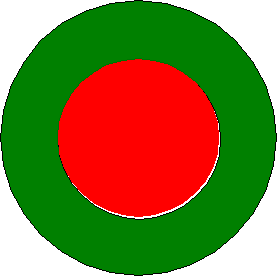Click for a direct link to :
Arma de Aeronáutica (Army Aviation)
Aviação Naval (Naval Aviation)
Força Aérea Portuguesa (Portuguese Air Force)
|
|
|
|
|
| Tiger Moth | Sintra | 1-2-3-4... | 100-101-102-103... |
| Tiger Moth | Tancos | 10-11-12-13... | 135-136-137-138... |
| Morane | Sintra | 2-3-4-5... | 150-151-152-153... |
| Morane | Tancos | 6-7-8-9... | 180-181-182-183... |
For
instance, in November 12, 1935 when the Moranes 151, 152, 192 and 194 were
transferred to Tancos, they were given at that location the serials respectively
185,186 183 and 184 (and they were painted on the aircraft).
On the same date the Moranes 183 and 184, which had been based at Tancos
were attributed to Sintra where they maintained these serials.
So, during some time (1936-37), two serials were being used by four
aircraft simultaneously: Moranes 183 and 184 were flying at Sintra,
at the same time that other two Moranes, but also serialled 183 and 184,
were flying from Tancos!
Also there were cases of different aircraft having the same block of serials assigned : that was the case of Tiger Moth and Ju-52- both using the 100 to 110 block, and the range 125 to 137 being used at the same time by the Avro 626 and Tiger Moth.
On the other hand this system was not applied immediately everywhere,
as in October of 1935, there were still instances of aircraft flying with
the old sequence system.
4 - Block numbering system - 2nd version
After the restructuring of 1937 (see Portuguese
Military Aviation in Brief), and to put some order in a system full
of irregularities as mentioned above, a new numbering system was created
with the Circular (Regulation) 642 of June 3, 1938.
This Regulation adopted the same block system as the previous
one, but this time more clearly defined, as such to the eight types
of aircraft then in service, were given blocks of 50 serials from 101 to
450. The block 501 to 549 was assigned to special aircraft, either because
were bought as test specimens or were single examples of a certain type.
Follows a transcription of the most important paragraphs of the mentioned Circular :
a) The basic serials to be adopted are the following:
|
|
|
| Tiger Moth | 101 - 150 |
| Avro and Morane | 151 - 199 |
| Junkers Ju-52 | 201 - 250 |
| Junkers Ju-86 | 251 - 299 |
| Potez | 301 - 340 |
| Vickers | 351 - 380 |
| Fury and Hind | 401 - 420 |
| Gladiator | 451 - 499 |
| Various (Dragon, Caproni, etc.) | 501 - 549 |
c) The Vickers 200-201-202-203-204-205-206-207-209-210-211-212-213-214-
225-226-227-228-235 and 236 are given the serials 351 to 370.
d) The Ju-52 serialled 101 to 110 are given the serials 201 to 210.
e) The Hind 275-276-277 and 278 are given the serials 404 to 407.
f) The Tiger Moth 100 is re-serialled 120.
The Avro 150 changes to 170.
The Junkers Ju-86 serialled 250 changes to 260.
The Fury 400 changes to 403
g)
All the aircraft Tiger Moth, Morane, Potez, Ju-86, Fury, with the exceptions
mentioned in f) as well as the Avros not mentioned on b), and various others
(Dragon and Caproni) maintain the actual serials.
Also it was clearly stated that the changes should be "in effect as soon as possible", and the aircraft should maintain their serials when affected to other bases.
During the W.W.II period, a large number of aircraft was incorporated in the "Arma de Aeronáutica" at the same time, forcing the use of serials that had been assigned to aircraft retired meanwhile.
So, the blocks starting in 510 and 600 were given to the Hawker Hurricanes. The 300 series occupied before by the Potez 25, already out of service, was used by the new Spitfire I, Airacobras and P-38 Lightning.
However, and as an oddity, the Spitfire V received still during the war and afterwards, was given the block 1 to 95.
The 700 block was used by the T-6 / Harvards received from 1947 and
after. The Airspeed Oxford occupied the 500 block which was used also by
the DH-84 Dragon (504 to 506).
5 - Alpha-numeric system
A special system was used during W.W.II, which consisted on the assignment
of alpha-numeric serials to some aircraft interned or force landed in Portugal
and used by the "Arma de Aeronáutica" - this was the case of the
6 Consolidated Liberators of different models, which were given the serials
L-1 to L-6, the Lockheed Hudson (H-1 to H-3) and Douglas C-47 (D-1).
6 - Independent numbering system
This system was used in Moçambique, by the aircraft which belonged
to the "Quartel General de Lourenço Marques" (Army Headquarters
at Lourenço Marques), around 1940.
They were given serials with one or two digits and the following cases
are known : Tiger Moth 1 to 9, Hornet Moth 10, General Aircraft Monospar
15, Avro Anson 20 and 21, and Beech Bonanza 25.
Late in 1946 these aircraft were assigned to the "Unidade de Instrução
Aeronáutica" (Aeronautical Training Unit).
With the implementation of Portaria (Regulation) 13602 of July 11, 1951 (see below) , the aircraft also received numbers in the new system, and in May 1952 some of them were incorporated in the "Força Aérea Portuguesa" : Tiger Moths with serials 1180 to 1188, Hornet Moth with serial 9201 and Beech Bonanza 9301.
7 - Four digits system
This system was introduced with Portaria (Regulation) 13602, of July 11, 1951.
This was a completely different system , and took some time to
be completely adopted. As such it was only fully implemented 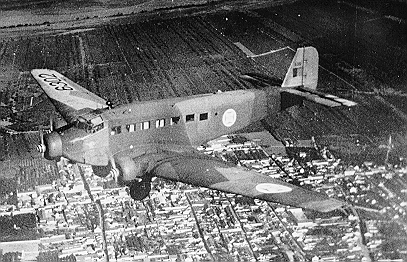 by
the new Air Force organization.
by
the new Air Force organization.
Anyway, the Nota (Note) 969 of June 8, 1951, of the 2ª
Repartição (2nd Department) stated that the new system was
to be applied only to the following aircraft in the inventory : Chipmunk,
Harvard / T-6, Junker Ju-52, C-47, B-17, C-54.
Even so, and later, other aircraft already in service in 1951 received
serials from the new system . It was the case of the Magister (12**), Oxford
(21**), Anson (22**), and Dragon (23**).
As another interesting fact a three view drawing of an Hurricane with
the serial 4202 was in the archives of Portuguese Air Force, representing
perhaps the idea of applying also the system to the famous British fighter.
However as far as we know this intention was never materialized.
Aviação
Naval (Naval Aviation)
In what concerns Naval Aviation, four systems
were used during its existence to assign serial numbers to aircraft:
1 - General sequential system
First system used, its application began in 1917
with the F.B.A hydros, and continued with the Donnet-Denhaut D.D.8 received
from the French Aeronavale, when leaving Aveiro, at the end of W.W.I. It
consisted in the assignment of the natural sequence of numbers (1,2,3...)
to each and one aircraft type. So, the F.B.A had serials 1,2,3 ,..
like the D.D.8.However, in the case of the D.D.8, not all the numbers were
assigned, as explained below.
2 - Unique sequential system
This new system consisted in the assignment of serials beginning at 1, but only in one series, and to all aircraft in service. This would effectively prevent two different aircraft of having the same serial, as happened in the first system.
In some cases, and to allow an easier identification, a second number
was given to each aircraft to represent its position within the
fleet. However, and in order to differentiate it from the proper serial
(usually painted in the rear fuselage) it was painted in the front fuselage
and in a bigger size. The photos show some examples.
The serial sequence went from 1 to 136, but more than 136 different aircraft were received. This was due to the fact that not only some aircraft used serials left by others out of service (case of the D.D.8 that "gave" serials to the Tellier T.3), but also because some types did not even used serials in the sequence (case of the Felixstowe F.3 and the Georges Levy).
There were also at least another two odd cases :
a) The General Aircraft Monospar as far as is known never received an identification (perhaps because of being the unique aircraft of that type)
b) Four DH-60G Gipsy Moths were delivered with floats from De Havilland,
and serialled 52 to 55. Due to crashes and other reasons, the fleet disappeared
in a short time. Subsequently another four aircraft were "re-manufactured"
from spare parts and parts of the retired or crashed aircraft, and received
the same serials ! They can be distinguished however from the former ones,
as they were "delivered" with wheels.
3 - Alpha numeric system
From 1943 the Naval Aviation received some aircraft from the United
Kingdom due to the reasons explained already in the brief history of our
military aviation.
As it happened, after the last example of the sequential system (the
136 serial given to a Short Sunderland I, ex RAF P9623 landed in emergency
in Portugal in February 1941, but only later put on service), a new system
was implemented.
To each type of aircraft was then assigned a serial consisting of two parts: the first part was a letter designating either the manufacturer or the mission, and the second part was a number separated from the letter by an hyphen, and designating the aircraft order within a fleet.
Some examples:
Beechcraft AT-11 and D-18S - BC-1 to BC-12
North American SNJ-4 - I-1 to I-8
Curtiss SB2C-5 Helldiver - AS-1 to AS-24
Bristol Beaufighter - BF-1 to BF-17
Also to some aircraft that had the serials applied in the previous system, a leetr was added before the serial, like in the G-21B 97 that began to display the serial G-97.
This system was used until 1952, when the Naval Aviation ceased to exist
due to integration of its aircraft in the new born Air Force.
4 - Integrated system
When the newly formed "Esquadrilha de Helicópteros da Marinha"
began to operate in 1993, their new Westland Lynx Mk.95 were given the
serials 9201 to 9205, in accordance with the rules then in use in the Air
Force. However, when the new Air Force system was introduced in 1993 they
also received the digit 1 before the assigned serials (becoming 19201 to
19205), and the serial colour changed from black to white. So, when the
frigate "Vasco da Gama" left Lisbon in February 3, 1995 for the Adriatic
to join the STANAVFORLANT forces, the Lynx aboard was already painted in
accordance with the new rule.
Below we present a list as complete as possible of the serials
assigned to the Naval Aviation aircraft :
|
|
|
|
| F.B.A.Type B | 1,2 | It seems 8 aircraft were bought. The first two delivered in 1917 received serials 1 and 2. The other 6 were damaged beyond repair during delivery voyage on ship.Later, a third aircraft was built with fuselage of the first and wings of the second, maintaining the serial of the fuselage ! Is the one on display nowadays at the Navy museum in Lisbon. |
| Donnet Denhaut D.D.8 | 1 to 18 | The aircraft 1,5,12,13,15,16,17 and 18 did not fly |
| Tellier T.3 | 1 ,5,12,13,15 | Took serials left by the D.D.8's |
| Georges Levy 40HB-2 | -- | Not used ? No serials assigned. |
| Felixstowe F.3 | -- | Used the c/n's as serials : F.4017 and F.4018 |
| Fairey IIID/IIID Mk.2 | 16 to 20 | The Fairey IID Mk.2 did not receive serial |
| Curtiss HS-2L | 21 to 24 | -- |
| Fokker T.IIIW | 25 to 28 | -- |
| Avro 504K | 29 to 31 | -- |
| Hanriot HD.41H | 32 to 37 | -- |
| C.A.M.S.37A | 38 to 45 | -- |
| Macchi M.18 | 46 to 51 | -- |
| DH-60G Gipsy Moth | 52 to 55 | Later other four aircraft took the same serials. See text |
| Junkers K.43W | 56 to 60 | -- |
| Fleet 10 | 61 to 65 | -- |
| Fleet 10G | 66 to 70 | -- |
| Hawker Osprey III | 71 and 72 | Only the two assigned to ships received serials. |
| Blackburn Shark IIA | 73 to 78 | -- |
| Fleet 10G | 79 to 81 | -- |
| Fleet 10 | 82 to 84 | -- |
| Avro 626 | 85 to 96 | -- |
| Grumman G-21B | 97 to 108 | -- |
| Fleet 10B | 109 to 118 | -- |
| Grumman Widgeon | 119 to 130 | -- |
| Fleet 16 | 131 to 135 | -- |
| Short Sunderland I | 136 | -- |
| Miles Martinet T.T.1 | M1 to M4 | -- |
| Airspeed Oxford I | O-1 to O-12 | -- |
| Bristol Blenheim IVF | B-1 to B-12 | -- |
| DH-82A Tiger Moth | T-1 to T-20 | -- |
| Bristol Beaufighter TF.X | BF-1 to BF-17 | 16 delivered initially. One crashed and replaced |
| Beech AT-11 Kansan | BC-1 to BC-7 | -- |
| Beech D-18S | BC-8 to BC-12 | -- |
| Curtiss SB2C-4 Helldiver | -- | -- |
| Curtiss SB2C-5 Helldiver | AS-1 to AS-24 | -- |
| Westland Lynx | 19201 to 19205 | -- |
The four digit system developed by the Army and explained above,
was continued by the Air Force. 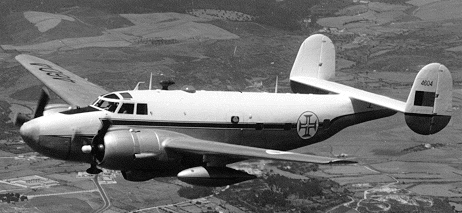
Seven basic functions for the aircraft in service were defined. These
functions corresponded to the first digit in a serial composed of four
digits. The second digit corresponded to a specific model of aircraft,
and the two remaining digits were assigned in sequence to the aircraft
model in question.
The application of this system to the Air Force aircraft was done as
follows:
| Serial | Aircraft model |
|
| 11** | Tiger Moth | Full serial only applied to aircraft integrated later in the Air Force coming from the Naval Aviation |
| 12** | Miles Magister | -- |
| 13** | DHC-1 Chipmunk | -- |
| 14** | Not used | -- |
| 15** | -- | Used in the 1970's coming for South Africa , but thought for the Miles Martinet (never used ?) |
| 16** | T-6/Harvard | -- |
| 17** | -- | Used by the Air Force for T-6 / Harvard's |
| 18** | -- | -- |
| 19** | -- | Used later by the T-33 / Silver Stars |
| -- | -- | -- |
| 21** | Oxford | -- |
| 22** | Anson | -- |
| 23** | Dragon Rapide | -- |
| 24** | Grumman Widgeon, later T-37 | -- |
| 25** | Beech AT-11, D-18S | -- |
| -- | -- | -- |
| 31** | Westland Lysander | Never applied ??. later used by Cessna 182C 3166 |
| 32** | Piper Super Cub | -- |
| 33** | -- | Used later by Broussard and DO-27 |
| 34** | -- | Used later by DO-27. Used by Cessna 401B as 3406 (this aircraft did not belong to FAP). |
| 35** | -- | Used later by Auster D.5 |
| 36** | -- | Used later by Piper Cherokee (3601-3604), Cessna 185A (3620-3624), Cessna 206 (3640), Cessna 310B 3651. |
| 37** | -- | Later applied to Reims-Cessna FTB 337 |
| -- | -- | -- |
| 41** | -- | Thought for Gladiators ? |
| 42** | -- | Thought for Hawker Hurricane, but as far as is known not used. |
| 43** | -- | -- |
| 44** | -- | First aircraft to receive serials in the Air Force - F-47 Thunderbolt |
| 45** | -- | Thought for the Helldiver, but as far as is known not used. |
| 46** | -- | Later applied for PV-2 |
| 47** | -- | Later applied to Neptune P2V-5 |
| -- | -- | -- |
| 51** | -- | Later applied to F-84G |
| 52** | -- | Later applied to F-84G |
| 53** | -- | Later applied to F-86F |
| 54** | -- | Later applied to Fiat G.91 |
| 55** | -- | Later applied to A-7P |
| 56** | -- | -- |
| 57** | -- | -- |
| 58** | -- | 5801 and 5802 applied later to two DH Vampires, and 5803 to a Jet Provost demonstrated in Lisbon |
| -- | -- | -- |
| 615* | C-47 / Dakota | -- |
| 62** | -- | -- |
| 63** | Ju-52 | -- |
| 64** | -- | Later applied to Nord Noratlas |
| 65** | -- | Later applied to Casa Aviocar |
| 66** | C-54 | -- |
| 67** | -- | Later applied to DC-6 |
| -- | -- | -- |
| 71** | SA-16 Albatross | Later applied to B-26 |
| 72** | -- | -- |
| 73** | -- | -- |
| 74** | SB-17G | -- |
| 75** | SC-54 / HC-54 | -- |
| -- | -- | -- |
| 88** | -- | Later Boeing 707-3F5C |
| -- | -- | -- |
| 91** | -- | Later H-19 |
| 92** | Hornet Moth | Later Alouette II and III |
| 93** | Beech Bonanza | Later Alouette III |
| 94** | -- | Assigned to G-21B but probably not used. Later used by Alouette III |
| 95** | -- | Later SA-330 Puma |
The following list although not originated from any official
document, was put together based on the analysis of the documents available,
and represents the concept for the serials assignment :
| First digit |
|
|
|
Single engine training |
|
|
Multi-engine training |
|
|
Reconnaissance / Observation |
|
|
Fighter or anti-submarine (Piston engine) |
|
|
Fighter (Jet engine) |
|
|
Transport |
|
|
Search and rescue or bomber (Piston engine) |
|
|
Reserved |
|
|
Miscellaneous |
The complete revision of the serials applied to the aircarft in service
was only completed by 1958. Even so, some aircraft coming
from the Naval Aviation, never received correct serials within this system.
It was the case of the Helldivers, which adopted the serials in the format
AS-**, applied above the Portuguese flag on the rudder.The same happened
to the Grumann G-21B which used the former Naval Aviation serial
(see photo) also above the flag on the rudder.
2 - Direcção de Serviço de Material (Material Department) instruction - August 5, 1969.
These rules introduced some slight changes in the system mentioned above, basically the meaning of the first digit : the "type" represented from then on a mix between the function/mission and type/class of aircraft. This was intended to solve a shortage of available serials and the simultaneous introduction of new types of aircraft.
The following "types" were then created:
|
|
|
|
|
Single engine training |
|
|
Multi engine training |
|
|
Reconnaissance / Observation |
|
|
Fighter (Piston engine) |
|
|
Fighter (Jet engine) |
|
|
Transport (Piston engine) |
|
|
Search and Rescue or Bomber (Piston engine) |
|
|
Multi engined jet (except fighter) |
|
|
Miscellaneous |
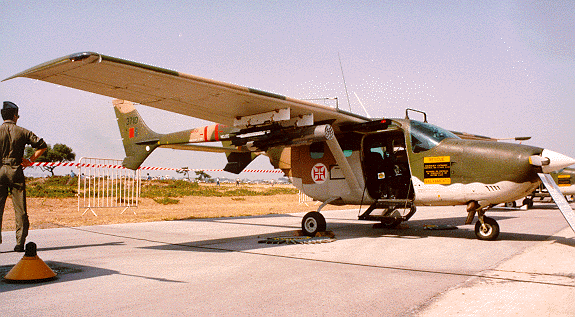
3 - Portaria (Regulation) 101/80 of March 12, 1980
This document approved and put in force the "Regulamento das Pinturas
Insignias e Marcas das Aeronaves da Força Aérea RFA 401-2"
(Rules for the Painting and Markings of the Aircraft of the Portuguese
Air Force).
It replaced the former one of July 1951, but did not change the
concept for serialling the aircraft. It only defined exactly the location,
colours and dimensions of the serials as applied on the aircarft.
4 - E.M.F.A. (Air Force Headquarters) / 3rd Division study - December
22, 1988
This aim of this study was to update the serialling system concept,
and to correct some deviations that had happened since the implementation
of the 1951/1969 system.
The most important deviations had been :
A-7P - Given serials in the range 5501 to 5550, being not fighters.
P-3P - Received the serial 4801 to 4806, which corresponded
to fighters with piston engines.
ASK-21 - Received the serials 1001 to 1004 being a sailplane/glider.
This new system would be a compromise between the existing system and
the needs arising from the automatic treatment of information. The criteria
defined then would force the change of all serial in the wole F.A.P. fleet.
However it was not approved, and the changes to the existing
fleet were not implemented.
The basis of the system would be the table shown below :
|
|
|
|
|
Sailplanes (gliders) with or without engine |
|
|
Conventional aircraft single engine |
|
|
Conventional aircarft multi-engine |
|
|
Turboprop aircraft single engine |
|
|
Turboprop aircraft multi engine |
|
|
Jet aircraft single engine |
|
|
Jet aircraft multi engine |
|
|
Helicopters single engine |
|
|
Helicopters multi engine |
5 - CEMFA (Chief of Staff of the Air Force) Directive - September 7, 1993
The so called "Sistema de Atribuição de Números de Matrícula" ( Serial Assignment System), was established in January 1, 1994, adding a fifth digit to the serial (five digit number). The following concept is in use:
1st digit - Series - It was considered that fleets not
in service at the implementation date would remain in the series
0, maintaining in consequence the 4 digits as before.
The fleets in service would receive the digit 1 in this position. This
also means that the first digit 0, used only for data systems handling,
should never be displayed in the aircraft. Unfortunately some aircraft
in statical dispaly received incorrectly the digit 0 !
2nd digit - Type - It is ssociated to the basic function
/ mission of the aircraft as detailed below:
|
|
|
|
|
No engine airplanes without engine |
|
|
Training single engine and sailplanes / gliders with engine. |
|
|
Training multi-engine |
|
|
Liaison / Reconnaissance |
|
|
Maritime patrol and bombers |
|
|
Fighters and fighter-bombers |
|
|
Transport |
|
|
Support and specials |
|
|
Reserved |
|
|
Helicopters and miscellaneous |
4th and 5th digits - Sequential number for the same aircraft model.
The implementation of this system forced the following re-seriallings:
ASK 21 from 1001-1004 to 10101-10104
Falcon 20 from 8101-8103 to 17101-17103
F-16A from 6601-6617 to 15101-15117 (this change was done before delivery)
F-16B from 6618-6620 to 15118-15120.
The system was used also for the first time in new FAP aircraft (besides the F-16) the Alpha Jet and the CASA Aviocar 212-300. These examples are detailed below :
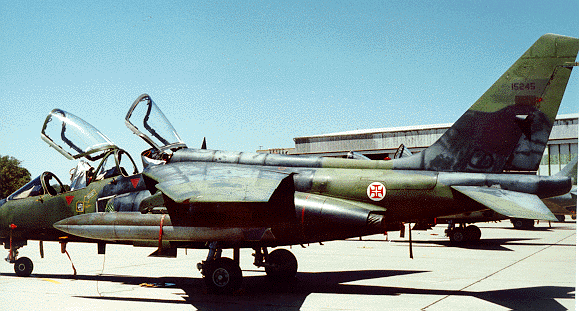
1 - Series, digit 1.
5 - Type: fighter-bomber.
2 - Second fleet of the same type (the first is the F-16)
01- First of the fleet up to 50.
CASA 212-300: Numbered 17201 to 17202
1 - series, digit 1
7 - Type, support and special. Aircraft equipped for aerial reconnaissance,
within the SIFICAP programme - Sistema de Fiscalização
e Controle das Pescas- (Fisheries Surveillance).
2 - Second fleet of that type (the first one is the Falcon 20, serialled
171**, for the ground navigation systems callibration)
01- First of the fleet
Bibliography-
1 - Records on author's collections of air activity of military aircraft, collected from pilots Log-books and Air Activity books of Air Bases (1977-1988)
2 - Portuguese Air Force Historical Archive - "Ordens de Serviço" and several documents kindly provided by Cel.José Carlos Montalvão Guimarães
3 - "Ordens de Serviço", Flight Records and many documents read in Air Bases 1, 3 and 6 (Sintra,Tancos and Montijo), (1978-1986)
9 - MAIS ALTO nº41, Year 5, May 1964.
10 - Peixoto,Lemos - "Homens e Aviões na História da Amadora" - Edition of Amadora Municipality 1980.
11- Lopes, Mário Canongia - "Os Aviões da Cruz de Cristo" - Dinalivro, Lisboa 1989
12 - Ferreira, Joaquim Guilherme Diniz "Aeronáutica Portuguesa" - Author's Edition, Lisboa 1961
13 - Cardoso, Edgar - "História da Força Aérea Portuguesa" - Gratelo SARL, Amadora 1981
14 - Many documents from the author's collections, and letters from friends, including Mr. T.R.Judge with invaluable help on the difficult subject of the Fleet aircraft.
